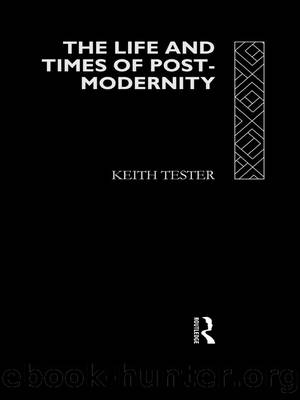The Life and Times of Post-Modernity by Keith Tester

Author:Keith Tester [Tester, Keith]
Language: eng
Format: epub
Tags: Social Science, Sociology, General
ISBN: 9781134859573
Google: zxuIAgAAQBAJ
Publisher: Routledge
Published: 2002-11-01T04:39:22+00:00
Chapter 5
Responsibility
Even the quickest survey of the history of social and cultural attitudes towards technology and the constructions of it reveals a very deep and serious tension. Indeed, to a very considerable extent the tension can be understood easily and fairly as yet another dimension of the dialectic between reification and reflexivity. I have of course been pursuing the thought that the perception and the identification of this dialectic is one of the key myths of European modernity and, therefore, the basic terrain of the intimation of the post-modern condition.
On the one hand, technology was accepted if not enthusiastically applauded. This was because it was identified with the material resources and guarantees of the ever better modern production and fabrication of an order of things. It offered certainties and security in the world which emerged out of the deconstruction of natural artifice. However and on the other hand, technology was just as often, if not more often, identified as actually or potentially quite terrible. According to this perspective, it might well have been the case that technology constituted the resources of societal self-sufficiency. But it was contended, these resources tended to themselves take over the meanings and the possibilities of the social life. The point to note is that neither of these attitudes or interpretations can be said to represent the definitively true or proper reading of the impact and significance of technology. Quite simply, they are both attempts to come to terms with the problems and possibilities which modernity involved. The one interpretation is, in itself, just as valid as the other.
In other words, it seems to be perfectly possible to identify the emergence and the playing out of something by way of a âdialectic of technologyâ within the condition and the arrangements of modernity. Each of the interpretations of technology goes hand in hand with the other. They lend each other a content, a purpose and importantly, a perceived counter-factual condition which seemingly demonstrates the rightness of the chosen attitude. The truth content of the counter-factual was simply taken to be located in its opposition to what was interpreted as the falsity of the prevailing fact. For example, technology can be vilified on the grounds of its horrific effects on the self-defining dimensions of life. Meanwhile any effort of self-definition can be dismissed on the grounds of its incompatibility with the construction of a standing-reserve which silently waits for animation by the defining resources of technology. Each interpretation finds its justification and replenishes its energies through a simple strategy of the turning around of everything which is said in the name and interest of the other interpretation.
Indeed, without a recognition of the dialectical interweaving of the interpretations of technology, any account of its social and cultural history will only tell one side of a far more diverse story. Or at least, that is how the situation seems from the point of view of a post-modern examination of the arrangements of modernity. However, within the modern forms themselves, largely
Download
This site does not store any files on its server. We only index and link to content provided by other sites. Please contact the content providers to delete copyright contents if any and email us, we'll remove relevant links or contents immediately.
Cecilia; Or, Memoirs of an Heiress — Volume 1 by Fanny Burney(32437)
Cecilia; Or, Memoirs of an Heiress — Volume 2 by Fanny Burney(31873)
Cecilia; Or, Memoirs of an Heiress — Volume 3 by Fanny Burney(31857)
The Great Music City by Andrea Baker(31488)
We're Going to Need More Wine by Gabrielle Union(18972)
All the Missing Girls by Megan Miranda(15586)
Pimp by Iceberg Slim(14397)
Bombshells: Glamour Girls of a Lifetime by Sullivan Steve(13977)
Talking to Strangers by Malcolm Gladwell(13229)
Norse Mythology by Gaiman Neil(13211)
Fifty Shades Freed by E L James(13158)
For the Love of Europe by Rick Steves(13051)
Mindhunter: Inside the FBI's Elite Serial Crime Unit by John E. Douglas & Mark Olshaker(9206)
Crazy Rich Asians by Kevin Kwan(9170)
The Lost Art of Listening by Michael P. Nichols(7411)
Enlightenment Now: The Case for Reason, Science, Humanism, and Progress by Steven Pinker(7239)
The Four Agreements by Don Miguel Ruiz(6636)
Bad Blood by John Carreyrou(6555)
Weapons of Math Destruction by Cathy O'Neil(6148)
